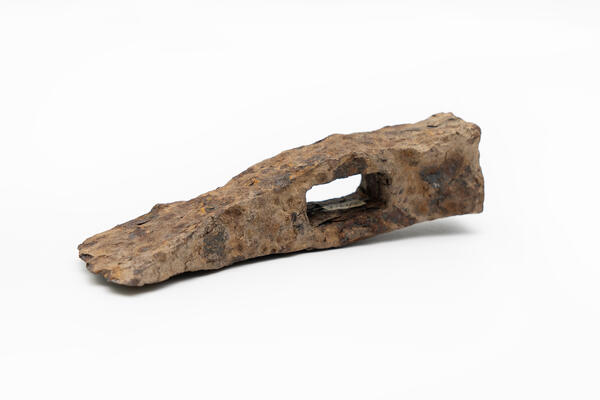The hollow iron celt from the collection of the Museum of Local Lore was cast in the first millennium BCE. An archaeological expedition discovered this object on the shore of the Siy river branch near Lake Bolon, 800 meters from the modern village of Achan in the Khabarovsk Territory and 80 kilometers south of Komsomolsk-on-Amur.
There were three archaeological cultures in the Amur region, which scientists attributed to the Early Iron Age. The Uril culture appeared at the turn of the first and second millennia BCE and existed approximately until the 5th century BCE, the Poltsevskaya culture was dated to the period from the 7th to the 4th century BCE, the Talakan culture — from the 5th to the 3rd century BCE. The tribes of these cultures had a settled way of life.
The first two cultures were engaged not only in hunting and fishing, but also in animal husbandry, gathering, and agriculture. In addition to ceramics, archaeologists found tools for grinding grain into flour, hoes, axes, knives, arrowheads, and beads in the settlements of the Uril culture. As a rule, all these items were made of stone; at the same time people used hoes, celts, knives made of slate and iron. Iron fishing hooks and harpoons were used in fishing, arrows and spears with tips made of bone, stone and iron were used for hunting and military affairs.
The iron celt from the exhibition is a type of ax. In addition to the most common specimens, that is, axes, the researchers also managed to identify specialized tools: celts-adzes and celts-shovels, which were used during the cutting of wood and farming, respectively.
Usually, celts were made rather narrow, somewhat expanding towards the blade. Unlike an ax, it was not a through hole that served to insert the handle, but a deep recess or rather a notch at the end opposite the blade.
In the past, in Western
archaeology, the term “celt” referred to any axes, adzes or hoes made of stone
or bronze. Today, in English archaeological terminology, this name has been
preserved for wedge-shaped polished stone axes that do not have a hole for the
handle.




